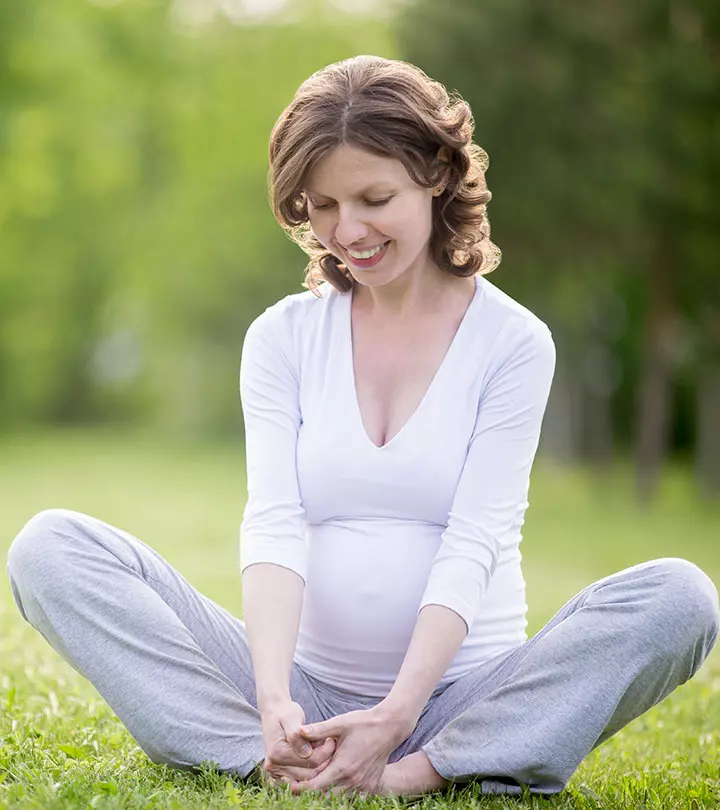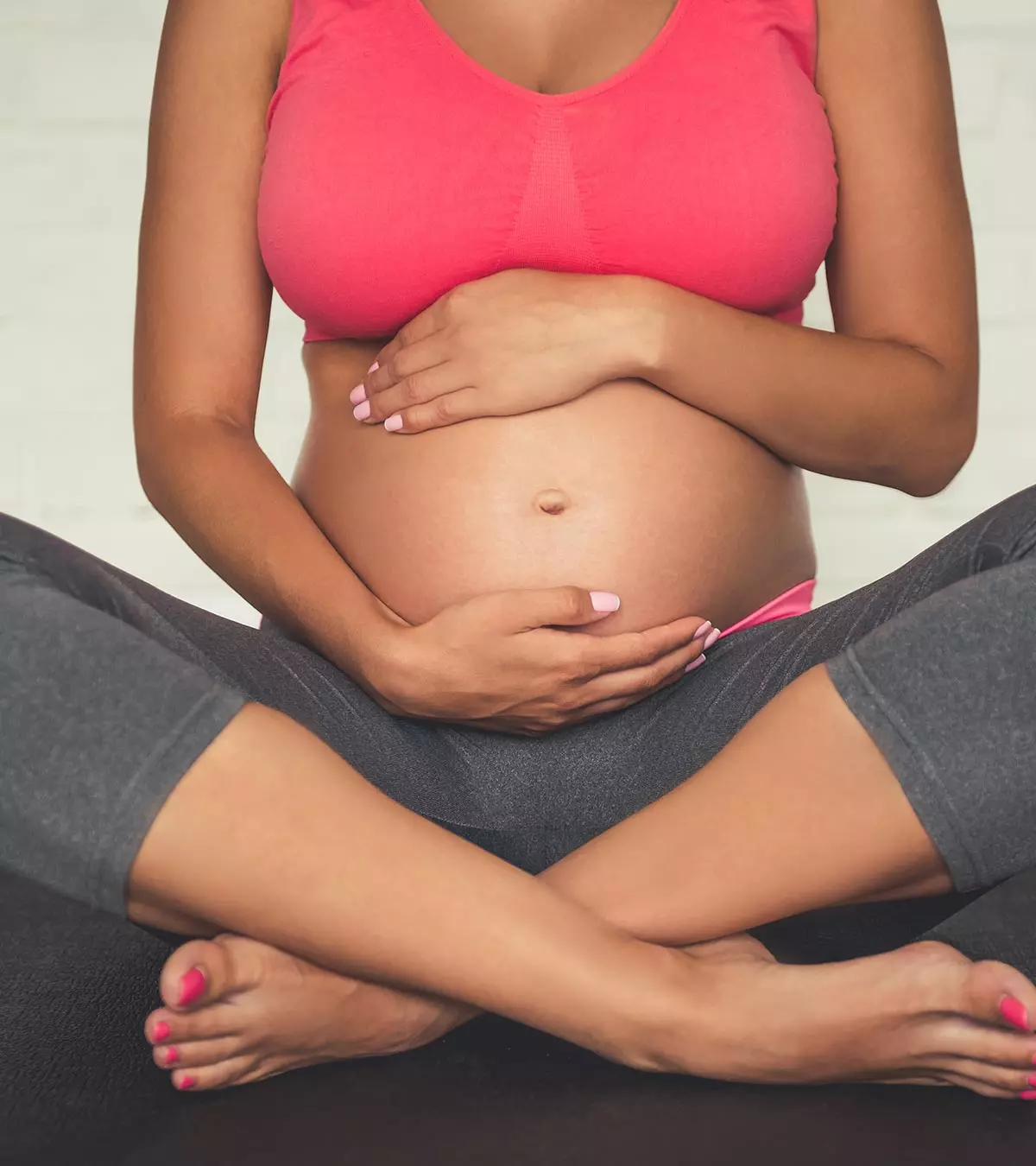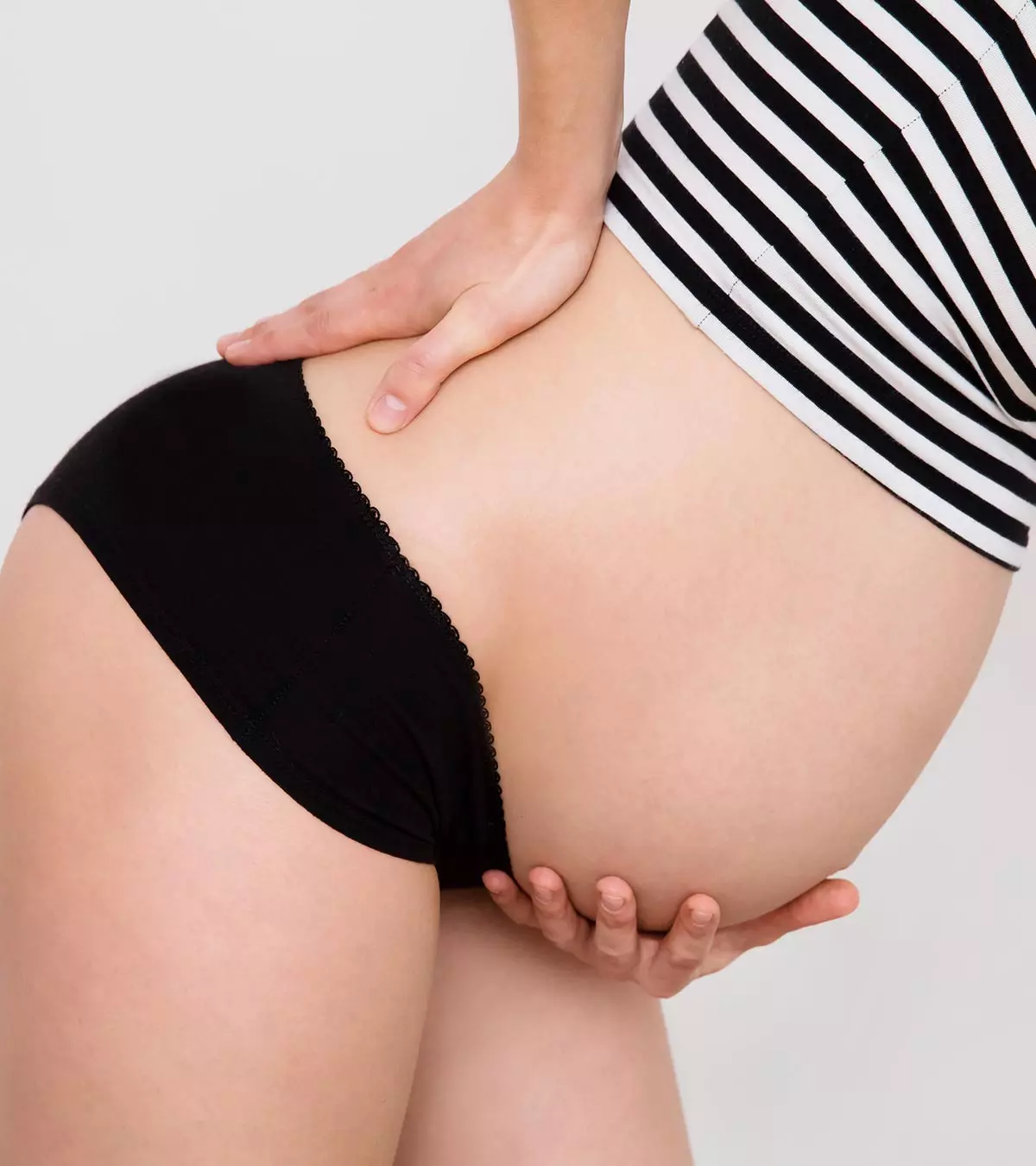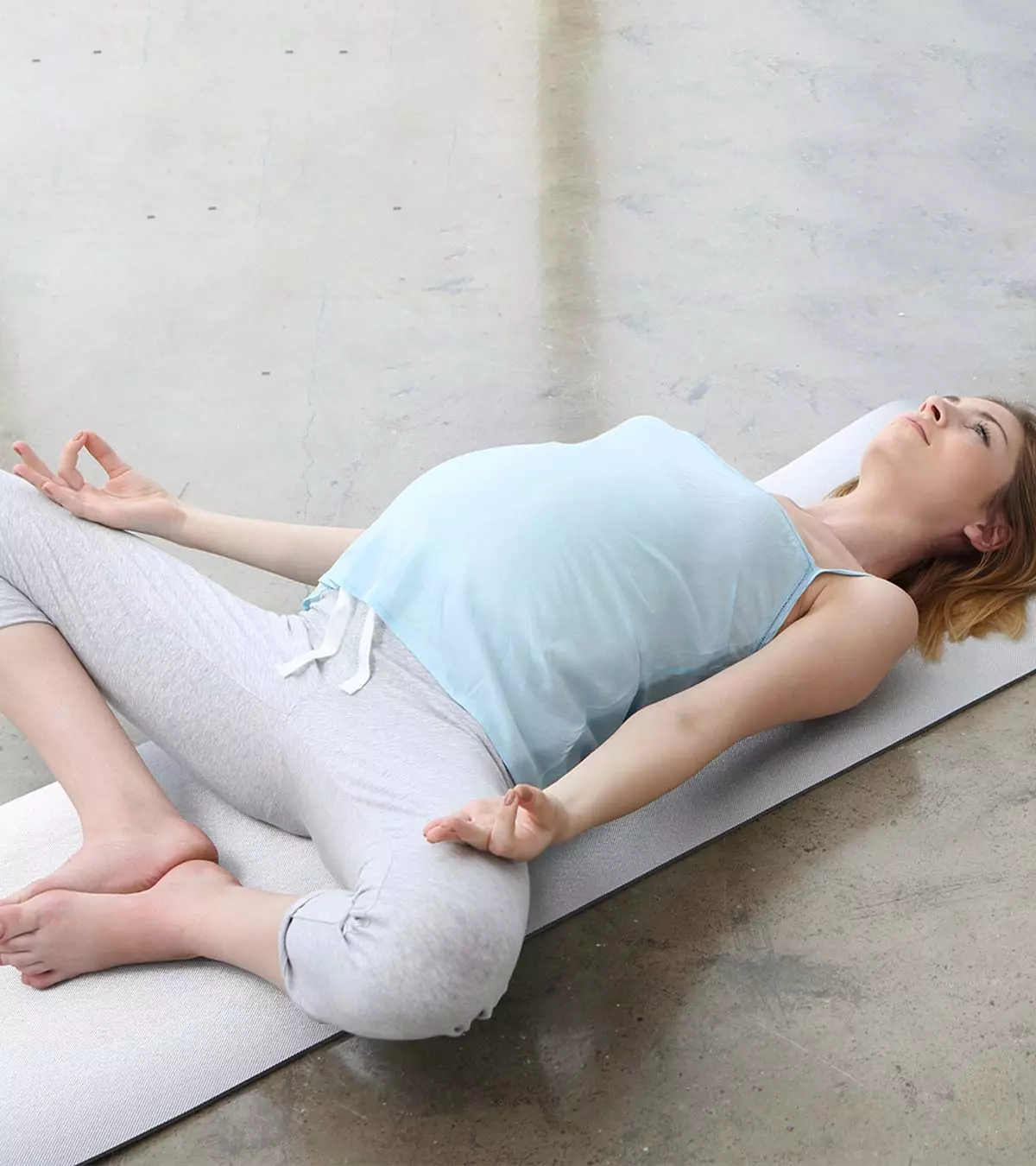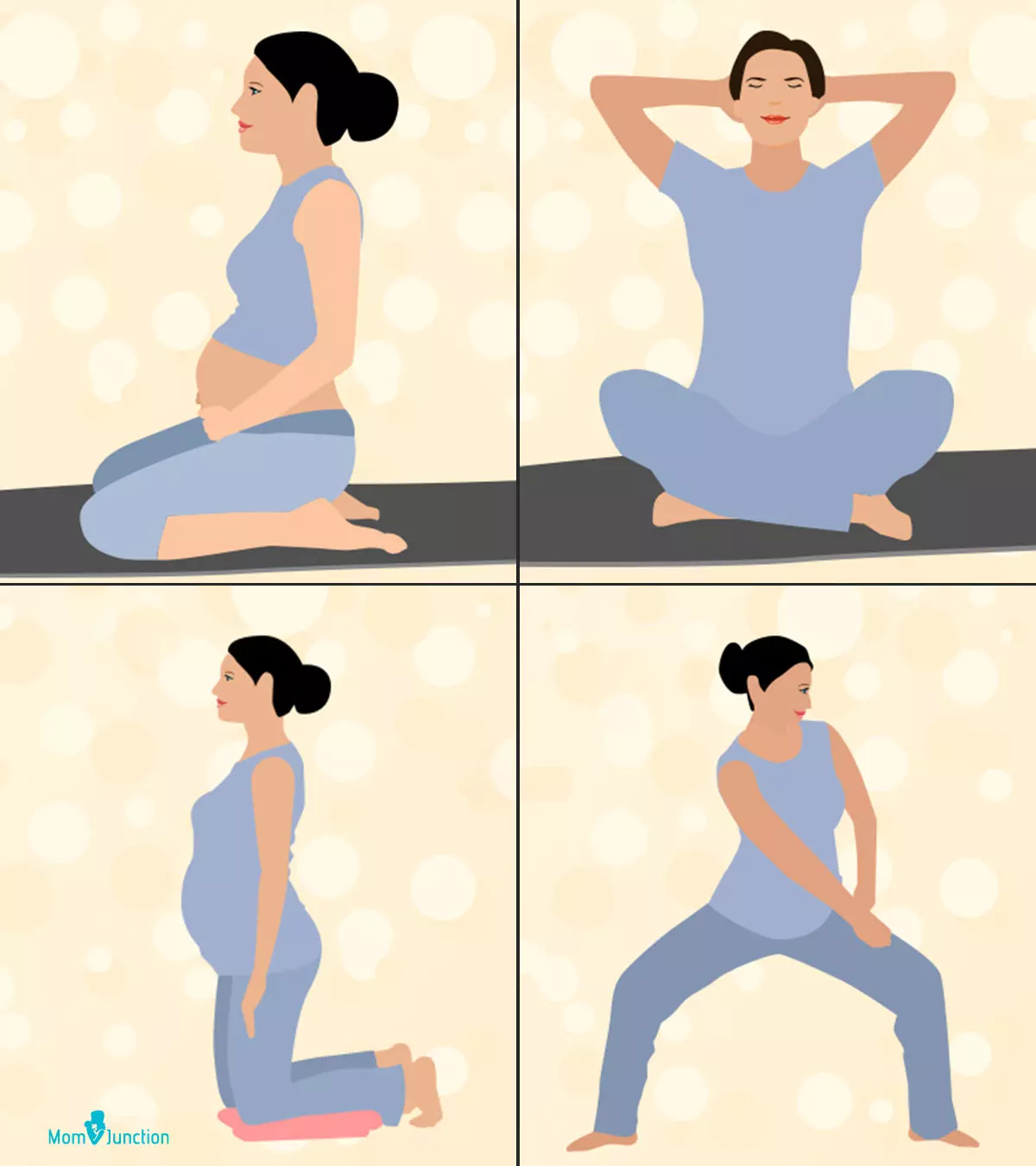
Image: MomJunction Design Team
Pilates is a form of low-impact exercise that improves flexibility and core strength of the body. It also enhances mental awareness. Pilates pregnancy exercises may have several benefits for expectant mothers, but not all are suitable for every gestation phase. However, you should check with your doctor before starting any workout during pregnancy and seek the guidance of a trained professional. This post tells you about pilates exercises and the precautionary measures for a safe and effective workout.

Key Pointers
- Pilates is generally a safe and beneficial form of exercise during pregnancy, with some precautions.
- Pregnant women should avoid exercises that require lying flat on the tummy, deep stretching, or jumping.
- The cat stretch, the sword, and pelvic floor muscle exercises are among the pilates exercises suited for all pregnancy trimesters.
- Pilates can help improve posture, balance, and strengthen muscles, providing benefits for both the mother and baby.
- Pregnant women should discontinue exercising if they feel tired or uncomfortable and seek a doctor’s opinion before starting a new pilates routine during pregnancy.
What Is Pilates?
Pilates is a versatile exercise developed by Joseph Pilates.
It aims at improving posture, movement and pelvic alignment. The movements focus on lower abdominal muscles, pelvic floor muscles, and back muscles, which are pivotal to your posture, strength, and balance. The exercises can be practiced either on a mat or by using equipment such as reformers, trapeze tables, exercise balls and resistance bands (1).
Is It Safe To Do Pilates During Pregnancy?
Dr. Laura Williams, a doctor of physical therapy and a board-certified women’s health clinical specialist from Salida, Colorado, says, “It is safe to begin pilates any time during pregnancy or to continue doing it throughout pregnancy if this was already a part of your fitness routine. Pilates is an excellent way to maintain the pelvic floor and a deep core range of motion, coordination, and strength throughout pregnancy. Do it as often as is tolerated without leading to excessive soreness, and the frequency of practice may change throughout pregnancy.”
You may do Pilates throughout pregnancy, provided your doctor considers it safe for you. While Pilates is usually safe and gentle, you should not over-exert your body or stretch too much (2). The series of controlled movements in Pilates can be modified to suit your tolerance levels.
All forms of Pilate exercises are safe to do during the initial stages of pregnancy. But from the 16th week, you should avoid activities that involve lying on your back (3).
What Are The Benefits Of Pilates While Pregnant?
Pilates mainly targets the muscles and their functioning, which are usually prone to problems such as loss of muscle tone, endurance, edemaiNoticeable swelling resulting from excessive fluid retention in the body , and poor balance, and postural issues during pregnancy.
Practicing Pilates regularly results in the following benefits:
1. Helps strengthen stomach and gluteal muscles
The relaxin hormone, released during pregnancy, makes the ligaments highly flexible. This flexibility can make hip, pelvic muscles and lower back vulnerable to injuries. Pilates can tackle this laxity in ligaments by focusing on the deep abdominal and glute muscles. It improves stability in the hip, pelvis and lower back regions, thus minimizing the pain and injuries (4).
2. Can provide some relief from back pain
Doing core abdominal exercises during pregnancy stabilizes the back and pelvic regions. Pilates also strengthens the posture and thus reduces back pain (5). Studies show that practicing core stabilization exercises during pregnancy can help reduce pain in the lower back and pelvic area. One randomized controlled trial found that women who followed these exercises had better pain relief, improved movement, and a higher quality of life than those who only received standard prenatal care (6).
3. Builds up pelvic floor
Pilates work on strengthening the hammock of the pelvic floor and supports the uterus, bladder, and bowel as your baby moves downwards with increasing weight. It will, therefore, prevent the risk of incontinenceiLack of control in excretion of urination or bowel movements when you sneeze or cough (7).
4. Helps gain control over breathing
Breathing is a key element of Pilates, and it is useful during pregnancy and labor. A stiffness develops in the upper back as the bump grows and that could hinder deep breathing. Pilates improves flexibility in this region and eases the breathing pattern (8).
5. Improves balance
It is natural for you to feel more clumsy or imbalanced during your maternity period. Pilates strengthens the core and enhances stability and balance, thus keeping you safe when you walk (9).
6. Helps reduce strain
Four-point kneeling positions (on your hands and knees) help reduce the excess load on your pelvis and lower back. They also help your baby get into the right birthing position (10).
7. Controls weight gain
Practicing gentle Pilates regularly will help prevent excess weight gain during pregnancy (10). Several studies have shown that Pilates exercises can positively influence metabolism in pregnant women. Women who participated in regular Pilates sessions tended to gain less weight during pregnancy compared to those who did not (11).
8. Strengthens legs
You are more likely to experience leg cramps, fluid retention, and varicose veinsiVeins that are dilated and swollen, typically seen in legs during pregnancy. Leg strengthening exercises can minimize such complications (10).
9. Offers relaxation
It is essential to take some time out for yourself. Pilates gives you that opportunity to switch off from everyday stress and relax (12).
10. Helps reduce postpartum fatigue
Pilates is a feasible workout to minimize postpartum fatigue. It can also lower the risk of depression and is useful in maintaining the health of the mother and the newborn (13). A clinical trial study divided 80 new moms into two groups. One group practiced Pilates five times a week for eight weeks, starting three days after giving birth. Each session was for 30 minutes. The findings show that compared to the group that didn’t exercise, the women who did Pilates felt less physically and mentally tired, had more energy, and felt more motivated to take on daily tasks (14).
 Research finds
Research findsNext, we talk about the different Pilates exercises for pregnant women.
9 Pregnancy Pilates Exercises (Suitable For All Trimesters)
Here are nine exercises that are safe and effective for you.
1. Pelvic floor muscle exercise
Strengthens pelvic floor muscles and prevents complications during and after delivery.
- Sit on your knees with legs together and butt on the heels. You can also choose to lie down with your head elevated and knees bent.
- Imagine that you are trying to control the urge to urinate. You will feel the muscles squeeze.
- Hold this position for ten seconds, and then relax gradually.
- Repeat it ten times.
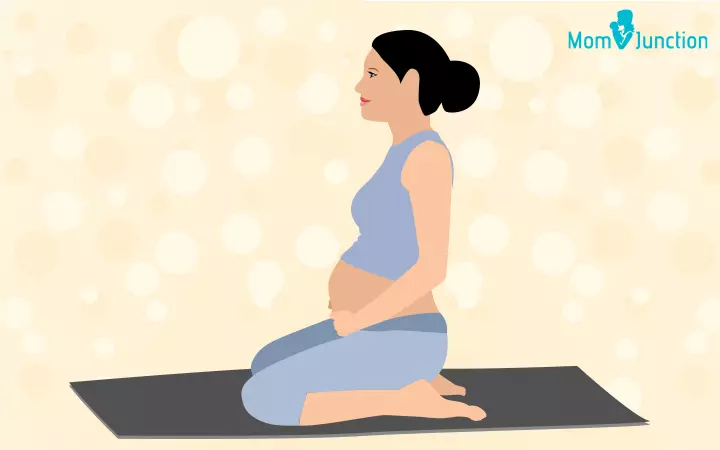
2. Deep tummy strengthening
Increases back support.
- Lie on one side with the knees slightly bent. Breathe in and breathe out. And try to pull in the tummy towards the spine.
- You can also try squeezing the pelvic floor muscles at the same time.
- Stay in this position for about ten seconds.
- Relax your tummy muscles gently and repeat it ten times.
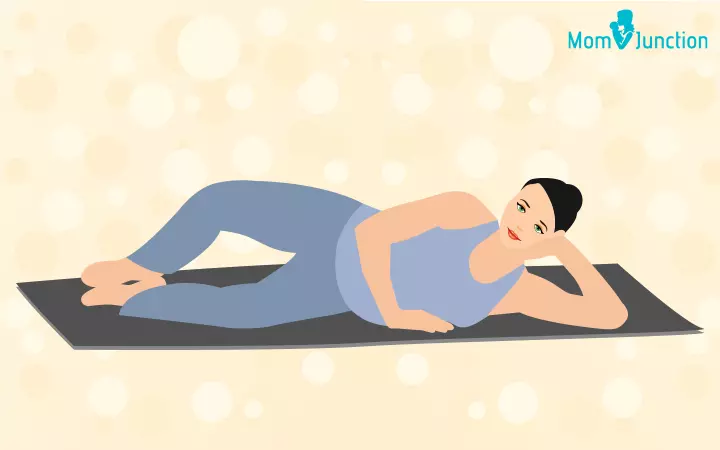
3. Pelvic tilts
Strengthens your lower back and pelvis. This exercise involves lying in a supine position. Hence, do not try this without consulting your physical trainer.
- Lie on your back with the head and shoulders elevated on a pillow, and knees bent. Breathe in gently.
- While breathing out, press your lower back down using the abdominal muscles. Your pelvis tilts, and the tailbone rises gently when you do this.
- Hold for about five to ten seconds.
- Repeat five to ten times.
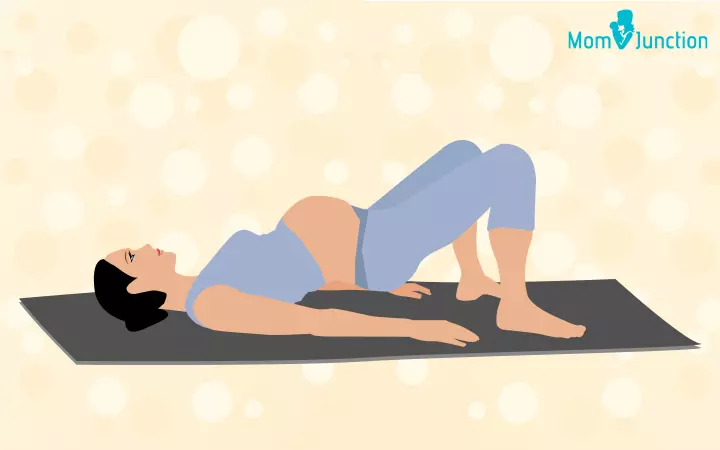
 Research finds
Research finds4. Upper back stretch
Improves your posture.
- Sit cross-legged with your back in an upright position and place your hands behind the head.
- Breathe in slowly.
- While breathing out, draw in your tummy and extend the back as you look up at the ceiling.
- Take another breath by squeezing your shoulders and resume to the starting position.
- Repeat it five to ten times.
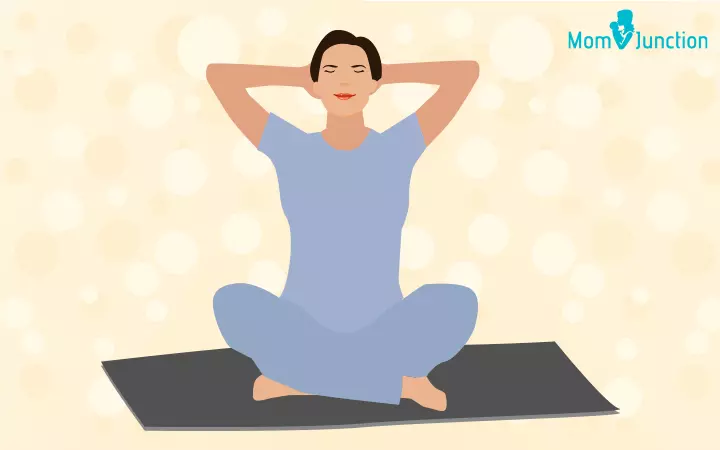
5. The cat stretch
Strengthens back muscles.
- Begin by getting on all fours – keep your hands beneath the shoulders and knees beneath the hips.
- Breathe in as you relax your tummy.
- While breathing out, draw the tummy inwards, arch your back upwards and bend your head down and look at the tummy.
- Breathe in again by gently going back to the starting pose.
- Repeat the same for about five to ten times.
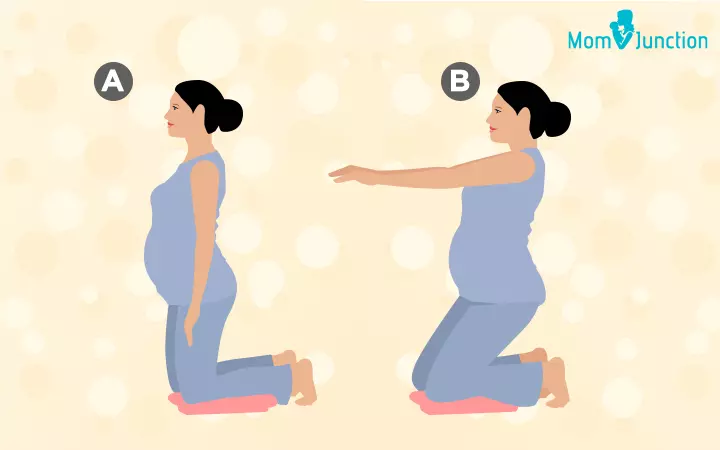
6. Thigh stretch
Strengthens abdominal muscles, lower back, hips, and buttocks.
- Kneel down on a carpet or mat with your knees hip-width apart, and pull in the abs.
- Lean back while breathing in and squeeze your butt, raise your arms parallel to the floor and palms facing down.
- Breathe out as you lower the arms down.
- Resume to the starting position.
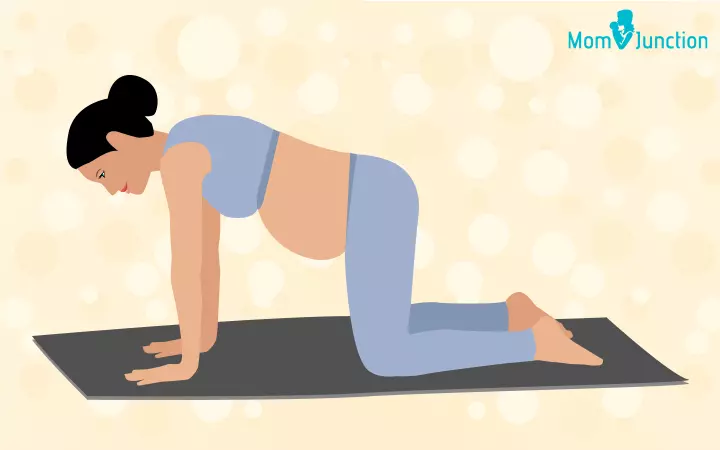
7. The sword
Improves balance and strengthens abdominal muscles, back, and legs.
- Stand with your feet apart, wider than your hips.
- Bend your knees and move the right hand towards the left knee as shown in the picture.
- Now raise your right hand upwards to the right, as you would take a sword out from the hip belt. Keep looking at the hand while doing so.
- Repeat the same with your left side.
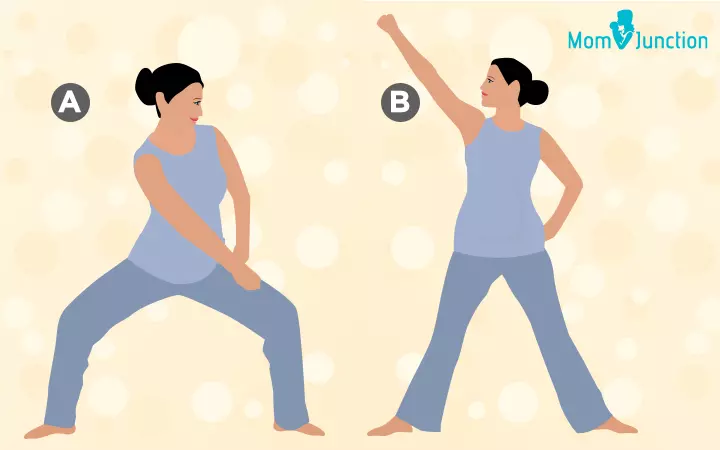
8. Sword arm
Improves balance, strengthens abs, arms, back, and hips.
- Kneel with the right knee and both hands placed on the floor. Stretch the left leg with abs pulled in and hips facing upwards.
- Breathe in as you draw the left hand to the sky and look up towards your hand.
- Breathe out by lowering the hand to the starting position.
- Switch to the left side and repeat.
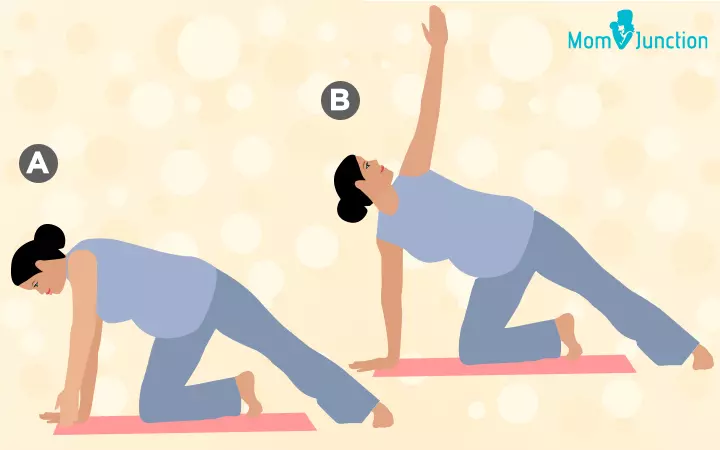
9. Wagging the tail
Improves flexibility, stability and strengthens the lower back and abs.
- Start on all fours and keep your wrists aligned to the shoulders.
- Suck in your belly, lift one knee and make circular movements with the leg.
- Repeat the same with another leg.
- Repeat three to four times.

 Point to consider
Point to considerAs we have mentioned above, you cannot do all the pilates exercises, there are also some exercises to avoid during pregnancy.
Pilates Exercises to Avoid During Pregnancy
Exercises that include back and stomach can cause discomfort or injuries to your body. Pilate exercises that are not appropriate to do during pregnancy include:
- Supine exercises that contract the rectus abdominis, such as lying on the back or double leg stretch (15).
- Exercises that involve lying on the tummy or any form of face-down plank positions.
- Deep stretches such as hamstring stretch, which is done by lying on the back and getting one leg perpendicular to the body, should be avoided.
You may do the other pregnancy exercises but only with your doctor’s approval. Also, take every care not to hurt yourself while doing Pilates.
Williams suggests, “You can perform many reformer exercises through pregnancy, specifically those on hands and knees, kneeling, side-lying, and standing. Lying supine may decrease blood supply to the fetus during the second and third trimester. Signs of this will be dizziness, nausea, or lightheadedness. At this time, supine exercises should be excluded, but many other modifications are available.”
Precautions For An Effective Pilate Workout
Pilates is considered to be safe during pregnancy, but a few precautions can help you avoid injuries and get maximum benefits from the workout:
- Choose an experienced instructor who can assist you with the exercise. Get your posture, abdominal and pelvic floor strength assessed to find the right Pilates workout for you.
- Monitor your energy levels and do not over-exercise.
- Avoid abdominal curls and crunches, and overstretching your joints.
- Wear comfortable and non-restrictive clothing. The American College of Obstetrics (ACOG) recommends wearing a sports bra to keep your breasts comfortable. In the later stages of pregnancy, a belly support belt can help reduce strain (16).
- Mind your balance with a growing belly. Avoid getting off the floor quickly.
- Do not lie flat or with your feet raised over your head during the second half of pregnancy. This can pressurize your blood vessels leading to the reduced blood supply to the heart (16).
- Focus on posture, gentle contractions, and pelvic floor muscles in the later stages of pregnancy.
- Stay hydrated and avoid exercising in hot and humid conditions. If you feel lightheaded, notice your heart beating faster than usual, or see that you’re urinating less or your urine is dark yellow, these may be signs that your body needs more fluids. (16).
- If you feel any discomfort or fatigue, stop the exercise immediately.
- Do not exercise soon after eating or on an empty stomach. Exercise about one to two hours after a meal.
Yoga Vs. Pilates For Pregnancy
Pregnancy Pilates is all about working on the muscles used for childbirth (17) whereas yoga focuses on a broad spectrum of the body system (18). Pregnancy Pilates assures balance, coordination, and strength of the muscles. Performing yoga asanas during pregnancy may aid overall well-being by targeting issues such as aches, fatigue, cramps, emotional wellness, vitality, and more.
Frequently Asked Questions
1. Does the intensity of Pilates exercises need to be adjusted during pregnancy?
It is recommended to reduce the intensity of Pilates exercises and avoid activities that may cause overheating, hard knocks, jumping or bouncing, sudden changes in direction, or increase the risk of falling (19).
2. Are there any special breathing or concentration techniques associated with Pilates during pregnancy?
Pilates involves lateral chest breathing techniques that can improve core strength (20). It also includes specific breathing exercises, such as rib breathing, side bend breathing, and arm raises, which are helpful for upper body relaxation (21).
3. How often can I perform Pilates exercises during pregnancy?
You may aim for two sessions of pilates per week, with at least one day between sessions (19).
4. Which equipment is required for Pilates when pregnant?
While Pilates equipment such as a mat, ring, resistance band, reformer, chair, ladder barrel, foam roller, and stability ball can be used, their use should be under the guidance of an expert, especially during pregnancy.
5. Are there any contraindications for doing Pilates exercises during pregnancy?
Though contraindications for Pilates are not clearly demarcated, pregnant women are advised to avoid exercising if they have certain heart and lung problems, cerclage (stitch at the cervix), twins or triplets (or more), risk factors for preterm labor, placenta previaiA pregnancy complication in which the placenta either partially or fully blocks the cervix after 26 weeks of gestation, severe anemia, or preeclampsiaiA pregnancy disorder characterized by high blood pressure, water retention, and protein content in urine (20).
5. What should I wear for Pilates during pregnancy?
Wear comfortable, breathable, non-restrictive clothing that allows for a full range of motion while providing adequate support. Choose moisture-wicking maternity leggings or stretchy pants that can accommodate your growing belly. You may also opt for a supportive sports bra for added comfort. Avoid clothing that’s too tight around your abdomen or waist. Opt for cooler options like Capri-length pants or shorts in warmer weather or heated studios.
Pilates pregnancy exercises are low impact and safe to practice when pregnant. Pilates can help pregnant women with core strengthening, improving their flexibility, strength, and muscle tone. It also helps to maintain healthy weight throughout pregnancy. Regular pilates could reduce pregnancy-related backaches and support the delivery process since it strengthens the core muscles. You may inform your trainer to suggest suitable and safe pilates exercises during pregnancy when you are pregnant. It is also essential to practice prenatal exercises if the healthcare provider approves it based on individual factors.
Infographic: What Are The Benefits Of Pilates While Pregnant?
Plates is a low-impact exercise program that can improve strength and balance, reduce stress and alleviate common pregnancy discomforts such as back pain and swelling. Explore more of its benefits before you try out this exercise. But remember to consult your doctor to know the safety precautions and prevent complications.
Some thing wrong with infographic shortcode. please verify shortcode syntax
Illustration: Prenatal Pilates Exercises Safe During All Trimesters

Image: Stable Diffusion/MomJunction Design Team
Prenatal Pilates is the perfect way to stay fit and healthy during pregnancy. This video is a wonderful session designed by an expert to keep you safe and comfortable during all three trimesters.
References
- Christine E. Di Lorenzo; (2011); Pilates.
https://www.ncbi.nlm.nih.gov/pmc/articles/PMC3445206/ - Exercising While Pregnant: What You Need to Know.
https://healthcare.utah.edu/healthfeed/2025/01/exercising-while-pregnant-what-you-need-know - Exercise during pregnancy.
https://www.nct.org.uk/information/pregnancy/body-pregnancy/it-safe-exercise-during-pregnancy - June Kloubec; (2011); Pilates: how does it work and who needs it?
https://www.ncbi.nlm.nih.gov/pmc/articles/PMC3666467/ - Susan Sorosky et al.; (2008); Yoga and pilates in the management of low back pain.
https://www.ncbi.nlm.nih.gov/pmc/articles/PMC2684152/ - Mamipour, Hamed, et al; (2025); Effect of Core Stabilization Exercises on Pain, Functional Disability, and Quality of Life in Pregnant Women With Lumbar and Pelvic Girdle Pain: A Randomized Controlled Trial.
https://www.sciencedirect.com/science/article/abs/pii/S0161475423000234 - Tanner J. Coleman et al.; (2015); Intra-abdominal Pressure during Pilates: Unlikely to Cause Pelvic Floor Harm.
https://www.ncbi.nlm.nih.gov/pmc/articles/PMC4506704/ - Adi Balogh; (2005); Pilates and pregnancy.
https://pubmed.ncbi.nlm.nih.gov/15960329/ - Is Pilates-Based Exercise Effective in Improving Balance in Healthy Adults Over the Age of 18?
https://digitalcommons.pcom.edu/cgi/viewcontent.cgi?referer=https://www.google.co.in/&httpsredir=1&article=1241&context=pa_systematic_reviews - Pilates for Pregnant Women: A Healthy Alternative.
https://www.longdom.org/open-access/pilates-for-pregnant-women-a-healthy-alternative-2167-0420-1000366.pdf - Bilchinsky, Tatyana, et al; (2025); Pilates Exercises during Pregnancy: A Narrative Review.
https://www.sciencedirect.com/science/article/abs/pii/S1360859224003735 - Azam Sadeghi et al; (2015); The effect of progressive muscle relaxation on pregnant women’s general health.
https://www.ncbi.nlm.nih.gov/pmc/articles/PMC4700682/ - Farzaneh Ashrafinia et al.; (2015); Effect of Pilates exercises on postpartum maternal fatigue.
https://www.ncbi.nlm.nih.gov/pmc/articles/PMC4371197/ - Ashrafinia, F., et al; (2025); Effect of Pilates Exercises on Postpartum Maternal Fatigue.
https://pubmed.ncbi.nlm.nih.gov/25820848/ - Sally K. Hinman; (2015); Exercise in Pregnancy.
https://www.ncbi.nlm.nih.gov/pmc/articles/PMC4622376/ - Exercise During Pregnancy.
https://www.acog.org/womens-health/faqs/exercise-during-pregnancy/ - M. Bergamin et al.; (2015); Effects of a Pilates exercise program on muscle strength postural control and body composition: results from a pilot study in a group of post-menopausal women.
https://www.ncbi.nlm.nih.gov/pmc/articles/PMC5005852/ - Catherine Woodyard; (2011); Exploring the therapeutic effects of yoga and its ability to increase quality of life.
https://www.ncbi.nlm.nih.gov/pmc/articles/PMC3193654/ - Yoga and Pilates during pregnancy.
https://www.pregnancybirthbaby.org.au/yoga-and-pilates-during-pregnancy - Pregnancy pilates: key things you need to know if you are pregnant.
https://www.ifwip.org/pregnancy-pilates-2/ - Pilates Breathing Exercises for Upper Body Relaxation.
https://internationalmusician.org/pilates-breathing-exercises-for-upper-body-relaxation/ - Nasim Yousefi Ghandali et al.; (2025); The effectiveness of a Pilates exercise program during pregnancy on childbirth outcomes: a randomised controlled clinical trial.
https://bmcpregnancychildbirth.biomedcentral.com/articles/10.1186/s12884-021-03922-2 - Emel Sonmezer et al.; (2025); The effects of clinical pilates exercises on functional disability, pain, quality of life and lumbopelvic stabilization in pregnant women with low back pain: A randomized controlled study.
https://pubmed.ncbi.nlm.nih.gov/32986655/
Community Experiences
Join the conversation and become a part of our nurturing community! Share your stories, experiences, and insights to connect with fellow parents.
Read full bio of Dr. Sangeeta Agrawal
- Laura Williams is a doctor of physical therapy (DPT) from the University of Colorado School of Medicine and board-certified women’s health clinical specialist with six years of experience. She also works as a pelvic health consultant at her business Hearth Healing, LLC, where she offers individualized virtual postpartum support.
 Laura Williams is a doctor of physical therapy (DPT) from the University of Colorado School of Medicine and board-certified women’s health clinical specialist with six years of experience. She also works as a pelvic health consultant at her business Hearth Healing, LLC, where she offers individualized virtual postpartum support.
Laura Williams is a doctor of physical therapy (DPT) from the University of Colorado School of Medicine and board-certified women’s health clinical specialist with six years of experience. She also works as a pelvic health consultant at her business Hearth Healing, LLC, where she offers individualized virtual postpartum support.
Read full bio of Rebecca Malachi
Read full bio of Swati Patwal
Read full bio of Aneesha Amonz







